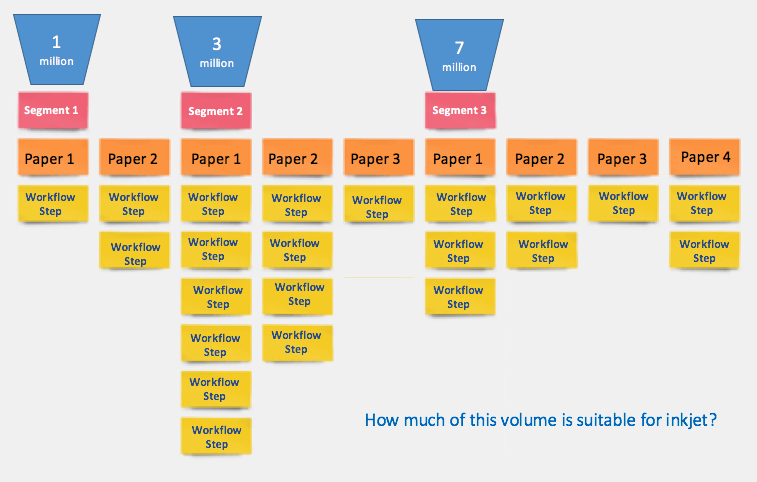One of the most frustrating things a consultant or analyst can hear from their clients is “you don’t need to know that.” I ask a lot of questions so I hear it on a pretty regular basis. Usually I get that answer when the particular executive has already made up their mind and really just wants someone on the outside to rubber-stamp it (I don’t own a rubber stamp) or when getting a real answer requires work.
It takes work to analyze production volumes
When evaluating what type of device to buy and when, or whether to consider inkjet at all, volume is a big factor. While the entry level threshold for production inkjet has come down significantly, most operations still need 3 to 4 million impressions per month to justify a roll-fed device and 1 to 4 million to justify a sheet fed device. You wisely note that those ranges overlap. This is where the type of volume is also important.
A company looking at low volume transaction printing has more options at a lower cost in the sheet fed market than a company looking for quality levels suitable for high color advertising and direct mail or marketing collateral. A company in the transaction print market is more likely to aspire to a roll-fed environment, should the volume warrant it, than a marketing oriented company that may use stocks too heavy for rolls. But, those generalizations are just that, generalizations. Every company is different. One company may break even on inkjet with 3 million images per month where another would require 5 million on the same device because of pricing models and a range of other factors.
Some companies do more than one thing…
Many companies go on their inkjet journey with a pre-conceived notion of what they need. It might be a single client that they want to convert, or they may believe that they can convert an entire book of business – but, very few want to dig into the data to really do an analysis of their book of business. (Except in-plant operations who must often go into excruciating detail to justify a purchase). I tell them – as I’m telling you – if you want to make good decisions, you need to take a long hard look at your entire book of business. Here are the common things that have come up when decisions are made without proper analysis:
- A commercial printer with a variety of long-run analog devices decides that inkjet is not a fit because it’s not nearly fast enough to handle the majority of their business –even if the price was competitive. However, they continue to turn away shorter run business that is a great fit for inkjet, and could potentially lead to more business with that client. Due to lack of analysis, they also fail to analyze the speed at which their average order size is shrinking.
- A high-quality direct marketing organization has a mix of offset and toner devices and believes that inkjet can’t deliver the print quality they need for their offset produced work. However, the majority of their toner-based work is well suited to inkjet and can be produced more cost competitively on that platform. This is discovered, not through their own analysis, but through losing several major clients to competitors with inkjet devices.
- Another company with a mixed book of business wants to make their inkjet decision based on the requirements one major client. Volumes for that client alone are enough to justify the purchase. They ended up with a great device for that client’s needs, but were missing a number of features needed to transition much of the remaining volume – making the investment far less profitable than it could have been.
- A similar company with a somewhat different mix of business looked at the volumes in terms of black and white, and color. They had nearly 8 million in monthly volume that looked like a great fit. They got a great device and a back-up for redundancy. They failed to analyze the volume in terms of paper requirements, finishing and software workflow. After 8 months they had only 3 million per month of their volume transitioned – barely enough to keep the heads wet on one high-volume machine. It took over a year to get the full volume transitioned. A very expensive year.
On the other hand, a small transaction printing organization with a few million per month in volume on sheet-fed toner devices did listen when we said look at all your volumes. They found that they had twice as much volume in black-only forms work as they did toner work that they could put onto inkjet. The increased volume will enable redundancy and drive their per image costs down by at least 20% from where they would have been at the lower volume threshold.
Here is the quintessential fact about inkjet and volume: Inkjet equipment becomes dramatically cheaper to run the closer to capacity you are able to run it. Conversely, if you justify an inkjet purchase on volumes you aren’t able to transition – your profitability drops like a rock.
To help you avoid some of these issues, we have a few tools that can be downloaded from Inkjet Insight:
- RFP Checklist: Production Inkjet Requirements
- RFP Checklist: Software Requirements
- Essential Software for Inkjet Success
While the tools above require premium access, you can also search for our series of free “What Matters” posts that talk about the key performance indicators that are important when evaluating inkjet for specific markets.
Editor’s note: this article was first published in October 2018 and remains evergreen for the 2023 environment.

